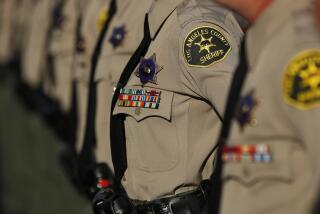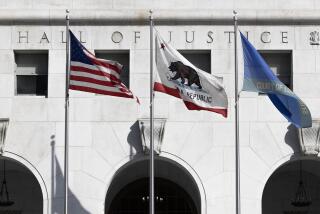O.C. Reserves Hired Despite Red Flags
Orange County Sheriff Michael S. Carona appointed four political allies to reserve deputy posts in 1999 over the objections of the department’s own background investigators, who raised concerns about prior drug use, a child endangerment accusation and lack of training.
Three of the four reserve officers remain with the department with badges, two have concealed-weapons permits and one has resigned.
Records reviewed by the Los Angeles Times show that two of the four reserves acknowledged prior use of LSD. Investigators said at the time that the department considered prior use of the powerful hallucinogen an automatic disqualifier, partly because of its potential for flashbacks and uneven behavior, records show.
The other two were named despite concerns that one had been accused of child endangerment and had recently filed for bankruptcy, while the other had not undergone required training.
One of the reservists, who remains in good standing with the program and is permitted to carry a gun, said he did not recall ever saying he had taken LSD. “I have no memory of saying that,” he said during a brief interview.
The Times is not naming any of the reserves.
The four reserves were among 86 political allies, friends, relatives and others appointed by Carona and his top assistants in 1999, before their background checks were complete. The 86 appointments came days before the state stiffened training requirements, and despite warnings from county lawyers about potential liability issues.
All were ultimately removed from the state’s peace officer database after it was determined their background checks were incomplete. The Sheriff’s Department allowed the reservists to keep their badges and, in some cases, their department-issued guns. In July, after several years of dispute between Carona and the state commission that oversees police training and standards, 56 reserves who had remained in the program were told they could regain their status if they completed training requirements.
Carona has denied anything improper in the handling of reserves or that any were appointed as political favors. And, he said, there was never any risk to the public in allowing the reserves to keep badges or guns.
The troubled reserve program is only one of several controversies dogging the sheriff as he makes a bid for a third four-year term. The assistant sheriff in charge of the reserve program, Donald Haidl, resigned in September 2004 to focus on his son’s gang-rape trial, and a former assistant sheriff, George Jaramillo, is now facing bribery charges.
Last month, two women -- both related to one of the former assistant sheriffs -- accused Carona of sexual harassment. In addition, one of his reserve officers is facing felony charges for allegedly pulling his service revolver on a group of golfers he thought were playing too slowly.
The four reserves flagged by background investigators were appointed when the volunteer program was rapidly expanding under the direction of Haidl.
Reserve volunteers assist the department’s rank-and-file deputies with duties that include traffic control and accompanying officers on patrol duty.
The Sheriff’s Department, through spokesman Jon Fleischman, declined to answer most questions submitted by The Times in writing about the four reserves. In a written statement, Fleischman said that background files and personnel records were confidential.
One of the reserves who admitted to past LSD use was a member of the sheriff’s transition committee that recommended changes to the department’s policy on concealed-weapons permits and hosted campaign fundraisers. On a pre-investigative questionnaire he said he took LSD as many as three times during the late 1960s, and also experimented with amphetamines, cocaine, marijuana and hashish, according to a report prepared by a background investigator.
The California Commission on Peace Officers Standards and Training, which credentials police agencies, has no specific policy relating to past drug use, leaving it up to the discretion of each department. The specific policies in Orange County and elsewhere are generally not made public because officials say it would compromise hiring practices.
Responding to The Times’ questions, the Sheriff’s Department denied that prior use of LSD or other drugs is an automatic disqualifier.
“Individual applicants are considered on a case-by-case basis, and prior drug use is not an automatic disqualifier,” said Fleischman in a written statement.
However, the background reports state that LSD -- at least at the time the background investigations were done -- is an “automatic disqualifier.”
One report warned of two liabilities: the safety risk associated with giving a gun to someone who might have a flashback; and the possibility of being sued by applicants who were rejected for prior drug use.
Three options were recommended: allow the reserve to downgrade to a level that carries no police powers, waive the LSD disqualification policy, or reject the person outright.
The reserve was appointed. The second reserve who admitted to LSD use was also appointed, but resigned last year for undisclosed reasons.
Another reserve, a Carona campaign donor, had been accused of child endangerment in 1993 and his children were removed from his home after a schoolteacher reported to authorities that the man’s daughter had been hit with chopsticks. Criminal proceedings were dropped after he was ordered to attend a diversion program, his background report shows. He does not have a concealed-weapons permit, but carries a badge.
An investigator wrote that the reserve -- who also filed for Chapter 7 bankruptcy about a week after he was appointed -- “could be an asset with his experience and contacts or with his two problem areas he could become a liability or an embarrassment to the department.”
The investigator said the appointee should no longer be considered a candidate, “based on the potential public relations damage if the media were to discover” his history, the report shows.
More to Read
Sign up for Essential California
The most important California stories and recommendations in your inbox every morning.
You may occasionally receive promotional content from the Los Angeles Times.










